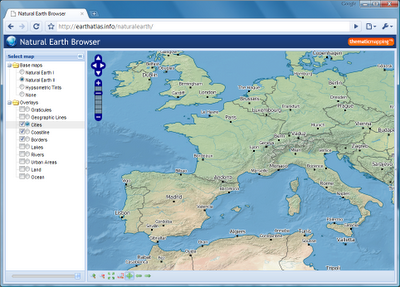Tom and I are pleased to announce the immediate availability of Natural Earth, free vector and raster map data at 1:10m, 1:50m, and 1:110m scales. This is a NACIS and MapGiving co-branded product with assistance from the University of Wisconsin-Madison cartography lab, Florida State University, and others.
Do you have a new theme to contribute to Natural Earth? Great! Please follow these data creation guidelines so it fits in with the rest of the project. Find an error? Log it via the Corrections system.
Why Create Natural Earth?
We have two goals:
First, to give cartographers an off-the shelf solution for creating small-scale world, regional, and country maps. To this end, Natural Earth Vector includes both cultural and physical features and builds on Tom Patterson’s Natural Earth raster data, first introduced in 2005.
Second, we include many features missing from people’s mental map of the world in the hope of improving overall geographic literacy.
Natural Earth Vector solves a problem that many NACIS members face: finding vector data for making publishable-quality small-scale maps. In a time when the web is awash in interactive maps and free, downloadable vector data, such as Digital Chart of the World and VMAP, mapmakers are forced to spend time sifting through a confusing tangle of poorly attributed data. Many cartographers working under tight project deadlines must use manually digitalized bases instead.
Small-scale map datasets of the world do exist, but they have their problems.
For example, most are crudely generalized—Chile’s fjords are a noisy mess, the Svalbard archipelago is a coalesced blob, and Hawaii has disappeared into the Pacific two million years ahead of schedule. They contain few data layers, usually only a coast and country polygons, which may not be in register with each other or modern satellite imagery. The lack of good small-scale map data is not surprising. Large mapping organizations that release public domain data, such as the US Geological Survey, are not mandated to create small-scale map data for a small user community that includes mapmaking shops, publishers, web mappers, academics, and students—in other words, typical NACIS members. Natural Earth Vector fills this oft-overlooked but important niche.
Collaboration
Making Natural Earth Vector is a collaboration involving many volunteer NACIS members. Nathaniel Vaughn Kelso and Tom Patterson began working on the project in late 2008. Following the path of least resistance, the idea was to repurpose existing data that we already had as an integrated world dataset at three map scales.
The 1:50 million and 1:110 million-scale data comes from bases developed by Dick Furno and additional staff at the Washington Post for quick turnaround newspaper mapping— the Washington Post Legal Department kindly granted us permission to use these data. The kernel for the 1:10 million data was a compilation by Patterson for the Physical Map of the World, consisting of coastlines, rivers, lakes, and physical feature labels. Expanding and improving on this foundation has been our chief activity.
The core team grew to include Tanya Buckingham, who coordinates data attributing by Ben Coakley, Kevin McGrath and Sarah Bennett at the University of Wisconsin Cartography Lab; Dick Furno as populated places guru; Nick Springer as the website developer; and Lou Cross as NACIS liaison.
A cast of consultants, many regulars on the Cartotalk.com discussion forum, assisted with place names for various world regions. They include Leo Dillon, Hans van der Maarel, Will Pringle, Craig Molyneaux, Melissa Katz-Moye, Laura McCormick, Scott Zillmer and fellow staff at XNR Mapping.
Data for cartography
We developed a world base map data suitable for making a variety of visually pleasing, well-crafted maps. Unlike other map data intended for scientific analysis or military mapping, Natural Earth Vector is designed to meet the needs of mainstream production cartographers. Maximum flexibility was a goal. For example, Natural Earth Vector comes in ESRI shapefile format, the Geographic projection, and WGS datum, which are de facto standards for vector geodata.
More »




















